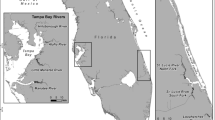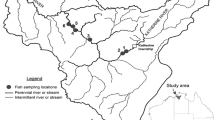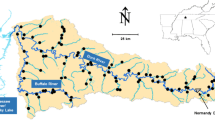Abstract
Coastal rivers provide habitat for fishes that have developed life-history strategies to take advantage of low salinity and high structural complexity. The coastal rivers of southeastern Florida have been ranked high for restoration at a national scale by conservationists because of the great potential for projects to benefit both human assets and aquatic communities. To help prioritize projects, a fisheries-independent monitoring dataset was analyzed to identify fish habitat using hotspot analysis and habitat suitability. An initial examination testing for broad seasonal changes (high vs. low freshwater inflow) in species distributions showed little change; thus, we concluded that static habitat (e.g., geomorphological features, shore types) was important for supporting fishes in this system. A river section, North Fork St. Lucie River, located 23–45 km from the river mouth and comprised of braided river channels and mangrove backwaters was a hotspot for economically important species such as common snook and red drum. The same river stretch supported a suite of regionally unique tropical species including opossum pipefish, smallscale fat snook, and bigmouth sleeper that had affinities for low salinity. Species were partitioned within this river stretch by salinity, depth, and shore type (e.g., smallscale fat snook compared to common snook used shorelines that were fresher, deeper, and had fewer mangroves). Restoration efforts can be prioritized by (1) maintaining low salinity (< 15) and reconnecting floodplains and riverine backwaters in the North Fork St. Lucie River, an area comprised of fish hotspots, and (2) exploring strategies to improve fish habitat in other areas currently less used.





Similar content being viewed by others
Data availability
All datasets generated or analyzed in the current study are available from the Florida Fish and Wildlife Conservation Commission, Fisheries-Independent Monitoring program upon request.
References
Adams AJ, Blewett DA (2004) Spatial patterns of estuarine habitat type use and temporal patterns in abundance of juvenile permit, Trachinotus falcatus, in Charlotte Harbor, Florida. Gulf Carib Res 16:129–139. https://doi.org/10.18785/gcr.1602.01
Allman RJ, Grimes CB (2002) Temporal and spatial dynamics of spawning, settlement, and growth of gray snapper (Lutjanus griseus) from the West Florida Shelf as determined from otolith microstructures. Fish Bull 100:391–403. http://hdl.handle.net/1834/31072
Arthaud DL, Greene CM, Guilbault K, Morrow JV (2010) Contrasting life-cycle impacts of stream flow on two Chinook salmon populations. Hydrobiol 655:171–188. https://doi.org/10.1007/s10750-010-0419-0
Baltz DM (1990) Autecology. In: Schreck CB, Moyle PB (eds) Methods for fish biology. American Fisheries Society, Bethesda, Maryland, pp 585–607
Baras E, Lucas MC (2001) Impacts of man’s modifications of river hydrology on the migration of freshwater fishes: a mechanistic perspective. Intl J Ecohydrol Hydrobiol 1:291–304
Barbier EB, Hacker SD, Kennedy C, Koch EW, Stier AC, Sillman BR (2011) The value of estuarine and coastal ecosystems services. Ecol Monogr 81:169–193. https://doi.org/10.1890/10-1510.1
Barnes T (2005) Caloosahatchee Estuary conceptual ecological model. Wetlands 25:884. https://doi.org/10.1007/BF03173126
Bayraktarov E, Sauders MI, Abdullah S, Mills M, Beher J, Possingham HP, Mumby PJ, Lovelock CE (2016) The cost and feasibility of marine coastal restoration. Ecol Appl 26:1055–1074. https://doi.org/10.1890/15-1077
Beck MW, Heck KL, Able KW, Childers DL, Eggleston DB, Gillanders BM, Halpern B, Hays CG, Hoshino K, Minello TJ, Orth RJ (2001) The identification, conservation, and management of estuarine and marine nurseries for fish and invertebrates: a better understanding of the habitats that serve as nurseries for marine species and the factors that create site-specific variability in nursery quality will improve conservation and management of these areas. BioSci: 633–641. https://doi.org/10.1641/0006-3568(2001)051[0633:TICAMO]2.0.CO;2
Beechie TJ, Sear DA, Olden JD, Pess GR, Buffington JM, Moir H, Roni P, Pollock MM (2010) Process-based principles for restoring river ecosystems. BioSci 60:209–222. https://doi.org/10.1525/bio.2010.60.3.7
Blewett DA, Stevens PW, Carter J (2017) Ecological effects of river flooding on abundance and body condition of a large, euryhaline fish. Mar Ecol Prog Ser 563:211–218. https://doi.org/10.3354/meps11960
Bortone SA, Dunson WA, Greenwalt JM (2004). Fishes as Estuarine Indicators. https://doi.org/10.1201/9781420038187.CRCPress,BocaRaton,FL
Bottom DL, Jones KK, Cornwell TJ, Gray A, Simenstad CA (2005) Patterns of Chinook salmon migration and residency in the Salmon River estuary (Oregon). Estuar Coast Shelf Sci 64:79–93. https://doi.org/10.1016/j.ecss.2005.02.008
Boucek RE, Trotter AA, Blewett DA, Ritch JL, Santos R, Stevens PW, Massie JA, Rehage JS (2019) Contrasting river migrations of Common Snook between two Florida rivers using acoustic telemetry. Fish Res 213:219–225. https://doi.org/10.1016/j.fishres.2018.12.017
Brame AB, McIvor CC, Peebles EB, Hollander DJ (2014) Site fidelity and condition metrics suggest sequential habitat use by juvenile Common Snook. Mar Ecol Prog Ser 509:255–269. https://doi.org/10.3354/meps10902
Brockmeyer RE, Rey JR, Virnstein RW, Gilmore RG, Earnest L (1997) Rehabilitation of impounded estuarine wetlands by hydrologic reconnection to the Indian River Lagoon, Florida. Wetlands Ecol Manag 4:93–109. https://doi.org/10.1007/BF01876231
Caro T (2010) Conservation by proxy: indicator, umbrella, keystone, flagship, and other surrogate species. Island Press, Washington, DC
Cianciotto AC, Shenker JM, Adams AJ, Rennert JJ, Heuberger D (2019) Modifying mosquito impoundment management to enhance nursery habitat value for juvenile common snook (Centropomus undecimalis) and Atlantic tarpon (Megalops atlanticus). Environ Biol Fish 102:403–416. https://doi.org/10.1007/s10641-018-0838-8
Flaherty KE, Guenther CB (2011) Seasonal distribution and abundance of blue crabs (Callinectes sapidus) in the Tampa Bay Estuary. Gulf of Mexico Sci 29:91–110. https://doi.org/10.18785/goms.2902.02
Flaherty KE, Switzer TS, Winner BL, Kennan SF (2014) Regional correspondence in habitat occupancy by gray snapper (Lutjanus griseus) within estuaries of the southeastern United States. Estuar Coasts 37:206–228. https://doi.org/10.1007/s12237-013-9652-x
Flaherty-Walia KE, Matheson RE, Paperno R (2015) Juvenile spotted seatrout (Cynoscion nebulosus) habitat use in a southwest Gulf of Mexico estuary: the effects of seagrass bed architecture, seagrass species composition, and varying degrees of freshwater influence. Estuar Coasts 38:353–366. https://doi.org/10.1007/s12237-014-9821-6
Frias-Torres S (2002) Oceanic transport and life history of the tropical western Atlantic opossum pipefish, Microphis brachyurus lineatus. Dissertation, Florida Institute of Technology.
Getis A, Ord JK (1992) The analysis of spatial association by use of distance statistics. Geograph Anal 24:189–206
Gilmore RG (1995) Environmental and biogeographic factors influencing ichthyofaunal diversity: Indian River Lagoon. Bull Mar Sci 57:153–170
Grantham TE, Newburn DA, McCarthy MA, Merenlender AM (2012) The role of streamflow and land use in limiting oversummer survival of juvenile steelhead in California streams. Transact Am Fish Soc 141:585–598. https://doi.org/10.1080/00028487.2012.683472
Green CM, Blackhard K, Nohner J, Candelmo A, Nelson DM (2014) A national assessment of stressors to estuarine fish habitats in the contiguous USA. Estuar Coasts 38:782–799. https://doi.org/10.1007/s12237-014-9855-9
Greenwood MFD, Matheson RE Jr, McMichael RH Jr, MacDonald TC (2007) Community structure of shoreline nekton in the estuarine portion of the Alafia River, Florida: differences along a salinity gradient and inflow-related changes. Estuar Coast Shelf Sci 74:223–238. https://doi.org/10.1016/j.ecss.2007.04.010
Halpern BS, Walbridge S, Selkoe KA, Kappel CV, Micheli F, D’Agrosa C, Bruno JF, Casey KS, Ebert C, Fox HE, Fujita R, Heinemann D, Lenihan HS, Madin EMP, Perry MT, Selig ER, Spalding R, Steneck R, Watson R (2008) A global map of human impact of marine ecosystems. Science 319:948–952. https://doi.org/10.1126/science.1149345
Hanke MH, Smith KJ, Digirolamo AL (2013) Spatial approach to understanding habitat utilization by silver perch (Bairdiella chrysoura) in northeast Florida estuaries. Florida Scientist 76:467–477. http://www.jstor.org/stable/24322001
Herren L, Sharpe B, Beal J, Tucker J, Conrad C (2010) Hydrological restoration of the North Fork St. Lucie River and Ten Mile Creek 2010 needs update. Florida Department of Environmental Protection. Ft. Pierce, FL.
Hijuelos AC, Sable SE, O’Connell AM, Geaghan JP, Lindquist DC, White ED (2017) Application of species distribution models to identify estuarine hotspots for juvenile nekton. Estuar Coasts 40:1183–1194. https://doi.org/10.1007/s12237-016-0199-5
Karr JR, Chu EW (2006) Seven foundations of biological monitoring and assessment. Biologia Ambientale 20:7–18
Kupschus S, Tremain D (2001) Associations between fish assemblages and environmental factors in nearshore habitats of a subtropical estuary. J Fish Biol 58:1383–1403. https://doi.org/10.1111/j.1095-8649.2001.tb02294.x
Lotze HK, Lenihan HS, Bourque BJ, Bradbury RH, Cooke RG, Kay MC, Kidwell SM, Kirby MX, Peterson CH, Jackson JBC (2006) Depletion, degradation, and recovery potential of estuaries and coastal seas. Science 312:1806–1809. https://doi.org/10.1126/science.1128035
Martin SB, Hitch AT, Purcell KM, Klerks PL, Leberg PL (2009) Life history variation along a salinity gradient in coastal marshes. Aquat Biol 8:15–28. https://doi.org/10.3354/ab00203
Mitchell A (2005) The ESRI guide to GIS analysis, 2nd edn. ESRI Press, Redlands
Munsch SH, Cordell JR, Toft JD (2017) Effects of shoreline armouring and overwater structures on coastal and estuarine fish: opportunities for habitat improvement. J Appl Ecol 54:1373–1384
Murphy MD, Taylor RG (1990) Reproduction, growth, and mortality of red drum Sciaenops ocellatus in Florida waters. Fish Bull 88:531–542. ISSN 0090–0656; e-ISSN 1937–4518
National Fish Habitat Board (NFHB) (2010) Through a fish’s eye: the status of fish habitats in the United States Association of Fish and Wildlife Agencies, Washington D.C. http://www.fishhabitat.org/sites/default/files/www/fishhabitatreport_Status.pdf. Accessed 25 Jan 2022
National Fish and Wildlife Foundation (NFWF) (2019) Regional coastal resilience assessment. https://www.nfwf.org/sites/default/files/coastalresilience/Documents/regional-coastal-resilience-assessment.pdf. Accessed 25 Jan 2022
Nordlie FG (2012) Life history characteristics of eleotrid fishes of the western hemisphere, and perils of life in a vanishing environment. Rev Fish Biol and Fish 22:189–224. https://doi.org/10.1007/s11160-011-9229-3
Ozerov MY, Veselov AE, Lumme J, Primmer CR (2012) “Riverscape” genetics: river characteristics influence the genetic structure and diversity of anadromous and freshwater Atlantic salmon (Salmo salar) populations in northwest Russia. Can J Fish Aquat Sci 69:1947–1958. https://doi.org/10.1139/f2012-114
Page LM, Espinosa-Perez H, Findley LT, Gilbert CR, Lea LN, Mandrak NE, Mayden RL Nelson JS (2013) Common and scientific names of fishes from the United States, Canada, and Mexico. 7th ed. Special Publication 34. American Fisheries Society, Bethesda, MD. https://doi.org/10.1080/03632415.2013.767244
Peterson MS, Meador MR (1994) Effects of salinity on freshwater fishes in coastal plain drainages in the southeastern U.S. Rev Fisheries Sci 2:95–121. https://doi.org/10.1080/10641269409388554
Poulakis GR, Shenker JM, Taylor DS (2002) Habitat use by fishes after tidal reconnection of an impounded estuarine wetland in the Indian River Lagoon, Florida (USA). Wetlands Ecol Manag 10:51–69. https://doi.org/10.1023/A:1014305310291
Prasannakumar V, Vijith H, Charutha R, Geetha N (2011) Spatio-temporal clustering of road accidents: GIS based analysis and assessment. Procedia Social Behavior Sci 21:317–325. https://doi.org/10.1016/j.sbspro.2011.07.020
RECOVER (2017) Southern coastal systems performance measure: juvenile spotted seatrout habitat quality. Restoration Coordination and Verification, US Army Corps of Engineers, Jacksonville, FL, and South Florida Water Management District, West Palm Beach, FL. February 2017
RECOVER (2020) Northern estuaries performance measure: salinity envelope. Restoration Coordination and Verification, US Army Corps of Engineers, Jacksonville, FL, and South Florida Water Management District, West Palm Beach, FL. July 2020
Roni P, Pess GR, Beechie TJ, Hanson KM (2014) Fish-habitat relationships and the effectiveness of habitat restoration. NOAA Technical Memorandum NMFS-NWFSC-127
Russell M, Greening H (2015) Estimating benefits in a recovering estuary: Tampa Bay, Florida. Estuar Coasts 38:9–15. https://doi.org/10.1007/s12237-013-9662-8
SAS Institute, Inc. 2006. SAS/STAT® 9.2 User’s Guide. SAS Institute Inc., Cary, North Carolina
Saxena R, Nagpal BN, Das MK, Srivastava A, Gupta SK, Kumar A, Jeyaseelan AT, Baraik VK (2012) A spatial statistical approach to analyze malaria situation at micro level for priority control in Ranchi district, Jharkhand. Indian J Med Res 136:776–782
Sime P (2005) St. Lucie estuary and Indian River Lagoon conceptual ecological model. Wetlands 25:898. https://doi.org/10.1672/0277-5212(2005)025[0898:SLEAIR]2.0.CO;2
Sklar FH, Browder JA (1998) Coastal environmental impacts brought about by alterations to freshwater flow in the Gulf of Mexico. Environ Manag 22:547–562
Stevens PW, Blewett DA, Poulakis GR (2007) Variable habitat use by juvenile common snook, Centropomus undecimalis (Pisces: Centropomidae): applying a life-history model in a southwest Florida estuary. Bull Mar Sci 80:93–108
Stevens PW, Greenwood MFD, Idelberger CF, Blewett DA (2010) Mainstem and backwater fish assemblages in the tidal Caloosahatchee River: implications for freshwater inflow studies. Estuar Coasts 33:1216–1224. https://doi.org/10.1007/s12237-010-9318-x
Stevens PW, Greenwood MFD, Blewett DA (2013) Fish assemblages in the oligohaline stretch of a southwest Florida river during periods of extreme freshwater inflow variation. Transact Am Fish Soc 142:1644–1658. https://doi.org/10.1080/00028487.2013.824920
Stevens PW, Dutka-Gianelli J, Nagid EJ, Trotter AA, Johnson KG, Tuten T, Whittington JA (2020) Niche partitioning among snook (Pisces: Centropomidae) in river of southeastern Florida and implications for species range limits. Estuar Coasts 42:1–13. https://doi.org/10.1007/s12237-019-00650-x
Taggart SJ, Mondragon J, Andrews AG, Nielsen JK (2008) Spatial patterns and movements of red king and Tanner crabs: implications for the design of marine protected areas. Mar Ecol Progr Ser 365:151–163. https://doi.org/10.3354/meps07493
Taylor RG, Whittington JA, Haymans DE (2001) Catch-and-release mortality rates of common snook in Florida. North Am J Fish Manag 21:70–75. https://doi.org/10.1577/1548-8675(2001)021%3c0070:CARMRO%3e2.0.CO;2
Tremain DM, Adams DH (1995) Seasonal variations in species diversity, abundance, and composition of fish communities in the northern Indian River Lagoon, Florida. Bull Mar Sci 57:171–192
Trotter AA, Ritch JL, Nagid E, Whittington JA, Dutka-Gianelli J, Stevens PW (2021) Using geomorphology to better define habitat associations of large-bodied fish, Common Snook Centropomus undecimalis in coastal rivers of Florida. Estuar Coasts 44:627–642. https://doi.org/10.1007/s12237-020-00801-5
US Army Corps of Engineers and South Florida Water Management District (USACE and SFWMD) (2020) Central and South Florida Project: Indian River Lagoon Final Project Implementation Report Environmental Impact Statement. Jacksonville and West Palm Beach, FL. https://usace.contentdm.oclc.org/utils/getfile/collection/p16021coll7/id/17494
Verıssimo D, MacMillan DC, Smith RJ (2011) Toward a systematic approach for identifying conservation flagships. Conservation Lett 4:1–8. https://doi.org/10.1111/j.1755-263X.2010.00151.x
Whaley SD, Christman MC, Burd MC Jr (2016) Spatial distribution–Abundance relationships in juvenile (Age 0) red drum (Sciaenops ocellatus) and spotted seatrout (Cynoscion nebulosus). II: Influence of major disturbances. Estuar Coasts 39:752–758. https://doi.org/10.1007/s12237-015-0027-3
Wiederholt RG, Stainback A, Paudel R, Khare Y, Naja M, Davis SE III, Van Lent T (2020) Economic valuation of the ecological response to hydrologic restoration in the Greater Everglades ecosystem. Ecol Indicators 117:106678. https://doi.org/10.1016/j.ecolind.2020.106678
Young JM, Yeiser BG, Whittington JA, Dutka-Gianelli J (2020) Maturation of female common snook Centropomus undecimalis: implications for managing protandrous fishes. J Fish Biol 97:1317–1331. https://doi.org/10.1111/jfb.14475
Funding
Field sampling and data analysis was supported with funds collected from the State of Florida Saltwater Fishing License sales, and US Department of the Interior, US Fish and Wildlife Service, Federal Aid for Sport Fish Restoration to the Florida Fish and Wildlife Commission. Data analysis was supported by the South Florida Water Management District, Agreement 4600004103, PO 9500008189.
Author information
Authors and Affiliations
Corresponding author
Ethics declarations
Ethics approval
All state and institutional guidelines for the care and use of animals were followed.
Competing interests
The authors declare no competing interests.
Additional information
Publisher's note
Springer Nature remains neutral with regard to jurisdictional claims in published maps and institutional affiliations.
Supplementary Information
Below is the link to the electronic supplementary material.
Rights and permissions
About this article
Cite this article
Stevens, P.W., Paperno, R., Beal, J.L. et al. Identification of fish habitat hotspots for use in prioritizing conservation and restoration projects in coastal rivers. Environ Biol Fish 106, 221–235 (2023). https://doi.org/10.1007/s10641-022-01226-8
Received:
Accepted:
Published:
Issue Date:
DOI: https://doi.org/10.1007/s10641-022-01226-8




